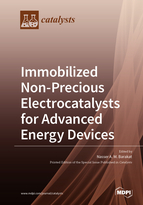Immobilized Non-Precious Electrocatalysts for Advanced Energy Devices
A special issue of Catalysts (ISSN 2073-4344). This special issue belongs to the section "Electrocatalysis".
Deadline for manuscript submissions: closed (30 June 2019) | Viewed by 42408
Special Issue Editor
Special Issue Information
Dear Colleagues,
The successful commercialization of advanced energy devices, including fuel cells and solar cells (e.g., dye-sensitized solar cells) is quite dependent on the cost, activity and durability of the electrocatalysts. Nowadays, precious metal electrodes are the mostly widely used. Accordingly, the manufacturing costs are relatively high, which constrains wide application. Recently, some reports have introduced some promising non-precious electrocatalysts to be exploited in both oxidation and reduction reactions. It was concluded that immobilization of the functional material on a proper support can distinctly improve catalytic activity. Moreover, due to the synergetic effect, metallic alloy nanoparticles show very good electrocatalytic activity in this regard.
This Special Issue aims to cover the most recent progress and the advances in the field of the immobilized non-precious electrocatalysts. This includes, but is not limited to, non-precious electrocatalysts for alcohol (e.g., methanol, ethanol, etc.) oxidation, oxygen reduction reaction and electrolyte reduction in dye-sensitized solar cells.
Prof. Dr. Nasser A. M. Barakat
Guest Editor
Manuscript Submission Information
Manuscripts should be submitted online at www.mdpi.com by registering and logging in to this website. Once you are registered, click here to go to the submission form. Manuscripts can be submitted until the deadline. All submissions that pass pre-check are peer-reviewed. Accepted papers will be published continuously in the journal (as soon as accepted) and will be listed together on the special issue website. Research articles, review articles as well as short communications are invited. For planned papers, a title and short abstract (about 100 words) can be sent to the Editorial Office for announcement on this website.
Submitted manuscripts should not have been published previously, nor be under consideration for publication elsewhere (except conference proceedings papers). All manuscripts are thoroughly refereed through a single-blind peer-review process. A guide for authors and other relevant information for submission of manuscripts is available on the Instructions for Authors page. Catalysts is an international peer-reviewed open access monthly journal published by MDPI.
Please visit the Instructions for Authors page before submitting a manuscript. The Article Processing Charge (APC) for publication in this open access journal is 2700 CHF (Swiss Francs). Submitted papers should be well formatted and use good English. Authors may use MDPI's English editing service prior to publication or during author revisions.
Keywords
- Electrooxidation
- Oxygen reduction reactions
- DSSCs counter electrode material
- Non-precious electrocatalysts
- Alloy nanoparticles
- Immobilized electrocatalysts






